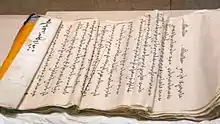Tai Le script
The Tai Le script (ᥖᥭᥰᥘᥫᥴ, [tai˦.lə˧˥]), or Dehong Dai script, is a Brahmic script used to write the Tai Nüa language spoken by the Tai Nua people of south-central Yunnan, China. (The language is also known as Nɯa, Dehong Dai and Chinese Shan.) It is written in horizontal lines from left to right, with spaces only between clauses and sentences.
| Tai Le Dehong Dai | |
|---|---|
 | |
| Type | |
| Languages | Tai Nüa, Ta'ang, Blang |
Time period | c. 1200 CE – present |
Parent systems | |
| Direction | Left-to-right |
| ISO 15924 | Tale, 353 |
Unicode alias | Tai Le |
| U+1950–U+197F | |
[a] The Semitic origin of the Brahmic scripts is not universally agreed upon. | |
| Brahmic scripts |
|---|
| The Brahmic script and its descendants |
The Tai Le script has a long history (700–800 years) and has used several different orthographic conventions.[1] Between 1952 and 1988, the script went through four reforms.[2] The third reform (1963/1964) used diacritics to represent tones, while the fourth reform (1988–present) uses standalone tone letters.[1][2]
Letters

In modern Tai Le orthographies, initial consonants precede vowels, vowels precede final consonants and tone marks, if present, follow the entire syllable.[1] Consonants have an inherent vowel /a/, unless followed by a dependent vowel sign. When vowels occur initially in a word or syllable, they are preceded by the vowel carrier ᥟ.
| Initials (IPA in brackets) | ||||||||||
| ᥐ [k] | ᥑ [x] | ᥒ [ŋ] | ᥓ [ts] | ᥔ [s] | ᥕ [j] | ᥖ [t] | ᥗ [tʰ] | ᥘ [l] | ||
| ᥙ [p] | ᥚ [pʰ] | ᥛ [m] | ᥜ [f] | ᥝ [v] | ᥞ [h] | ᥟ [ʔ] | ᥠ [kʰ] | ᥡ [tsʰ] | ᥢ [n] | |
| Finals (IPA in brackets) | ||||||||||
| ᥣ [a] | ᥤ [i] | ᥥ [e] | ᥦ [ɛ], [ia] | ᥧ [u] | ᥨᥝ [o] | ᥩ [ɔ], [ua] | ᥪ [ɯ] | ᥫ [ə] | ᥬ [aɯ] | |
| ᥭ [ai] | ᥣᥭ [aːi] | ᥧᥭ [ui] | ᥨᥭ [oi] | ᥩᥭ [ɔi] | ᥪᥭ [ɯi] | ᥫᥭ [əi] | ||||
| -ᥝ [au] | ᥣᥝ [aːu] | ᥤᥝ [iu] | ᥥᥝ [eu] | ᥦᥝ [ɛu] | ᥪᥝ [ɯu] | ᥫᥝ [əu] | ||||
| -ᥛ [am] | ᥣᥛ [aːm] | ᥤᥛ [im] | ᥥᥛ [em] | ᥦᥛ [ɛm] | ᥧᥛ [um] | ᥨᥛ [om] | ᥩᥛ [ɔm] | ᥪᥛ [ɯm] | ᥫᥛ [əm] | |
| -ᥢ [an] | ᥣᥢ [aːn] | ᥤᥢ [in] | ᥥᥢ [en] | ᥦᥢ [ɛn] | ᥧᥢ [un] | ᥨᥢ [on] | ᥩᥢ [ɔn] | ᥪᥢ [ɯn] | ᥫᥢ [ən] | |
| -ᥒ [aŋ] | ᥣᥒ [aːŋ] | ᥤᥒ [iŋ] | ᥥᥒ [eŋ] | ᥦᥒ [ɛŋ] | ᥧᥒ [uŋ] | ᥨᥒ [oŋ] | ᥩᥒ [ɔŋ] | ᥪᥒ [ɯŋ] | ᥫᥒ [əŋ] | |
| -ᥙ [ap] | ᥣᥙ [aːp] | ᥤᥙ [ip] | ᥥᥙ [ep] | ᥦᥙ [ɛp] | ᥧᥙ [up] | ᥨᥙ [op] | ᥩᥙ [ɔp] | ᥪᥙ [ɯp] | ᥫᥙ [əp] | |
| -ᥖ [at] | ᥣᥖ [aːt] | ᥤᥖ [it] | ᥥᥖ [et] | ᥦᥖ [ɛt] | ᥧᥖ [ut] | ᥨᥖ [ot] | ᥩᥖ [ɔt] | ᥪᥖ [ɯt] | ᥫᥖ [ət] | |
| -ᥐ [ak] | ᥣᥐ [aːk] | ᥤᥐ [ik] | ᥥᥐ [ek] | ᥦᥐ [ɛk] | ᥧᥐ [uk] | ᥨᥐ [ok] | ᥩᥐ [ɔk] | ᥪᥐ [ɯk] | ᥫᥐ [ək] | |
| Tone letters (current usage) | ||||||||||
| (unmarked) mid-level | ᥰ high-level | ᥱ low-level | ᥲ mid-fall | ᥳ high-fall | ᥴ mid-rise | |||||
| Tone diacritics (1963 orthography) | ||||||||||
| (unmarked) mid-level | ◌̈ high-level | ◌̌ low-level | ◌̀ mid-fall | ◌̇ high-fall | ◌́ mid-rise | |||||
Note that old orthography tone diacritics combine with short letters (as in /ka²/ ᥐ̈) but appear to the right of tall letters (as in /ki²/ ᥐᥤ̈).[1]
Unicode
The Tai Le script was added to the Unicode Standard in April 2003 with the release of version 4.0.
The Unicode block for Tai Le is U+1950–U+197F:
| Tai Le[1][2] Official Unicode Consortium code chart (PDF) | ||||||||||||||||
| 0 | 1 | 2 | 3 | 4 | 5 | 6 | 7 | 8 | 9 | A | B | C | D | E | F | |
| U+195x | ᥐ | ᥑ | ᥒ | ᥓ | ᥔ | ᥕ | ᥖ | ᥗ | ᥘ | ᥙ | ᥚ | ᥛ | ᥜ | ᥝ | ᥞ | ᥟ |
| U+196x | ᥠ | ᥡ | ᥢ | ᥣ | ᥤ | ᥥ | ᥦ | ᥧ | ᥨ | ᥩ | ᥪ | ᥫ | ᥬ | ᥭ | ||
| U+197x | ᥰ | ᥱ | ᥲ | ᥳ | ᥴ | |||||||||||
| Notes | ||||||||||||||||
The tone diacritics used in the old orthography (specifically the third reform) are located in the Combining Diacritical Marks Unicode block:
- U+0300 ◌̀ COMBINING GRAVE ACCENT
- U+0301 ◌́ COMBINING ACUTE ACCENT
- U+0307 ◌̇ COMBINING DOT ABOVE
- U+0308 ◌̈ COMBINING DIAERESIS
- U+030C ◌̌ COMBINING CARON
See also
- The New Tai Lue alphabet for the Tai Lü language, derived from the Old Tai Lue script "Dai Tam"; which is an abugida
References
- Everson, Michael (2001-10-05). "L2/01-369: Revised proposal for encoding the Tai Le script in the BMP of the UCS" (PDF).
- Zhou, Minglang (2003). Multilingualism in China: The Politics of Writing Reforms for Minority Languages, 1949-2002. De Gruyter. ISBN 978-3110178968.
External links
- Omniglot, Dehong Dai script
